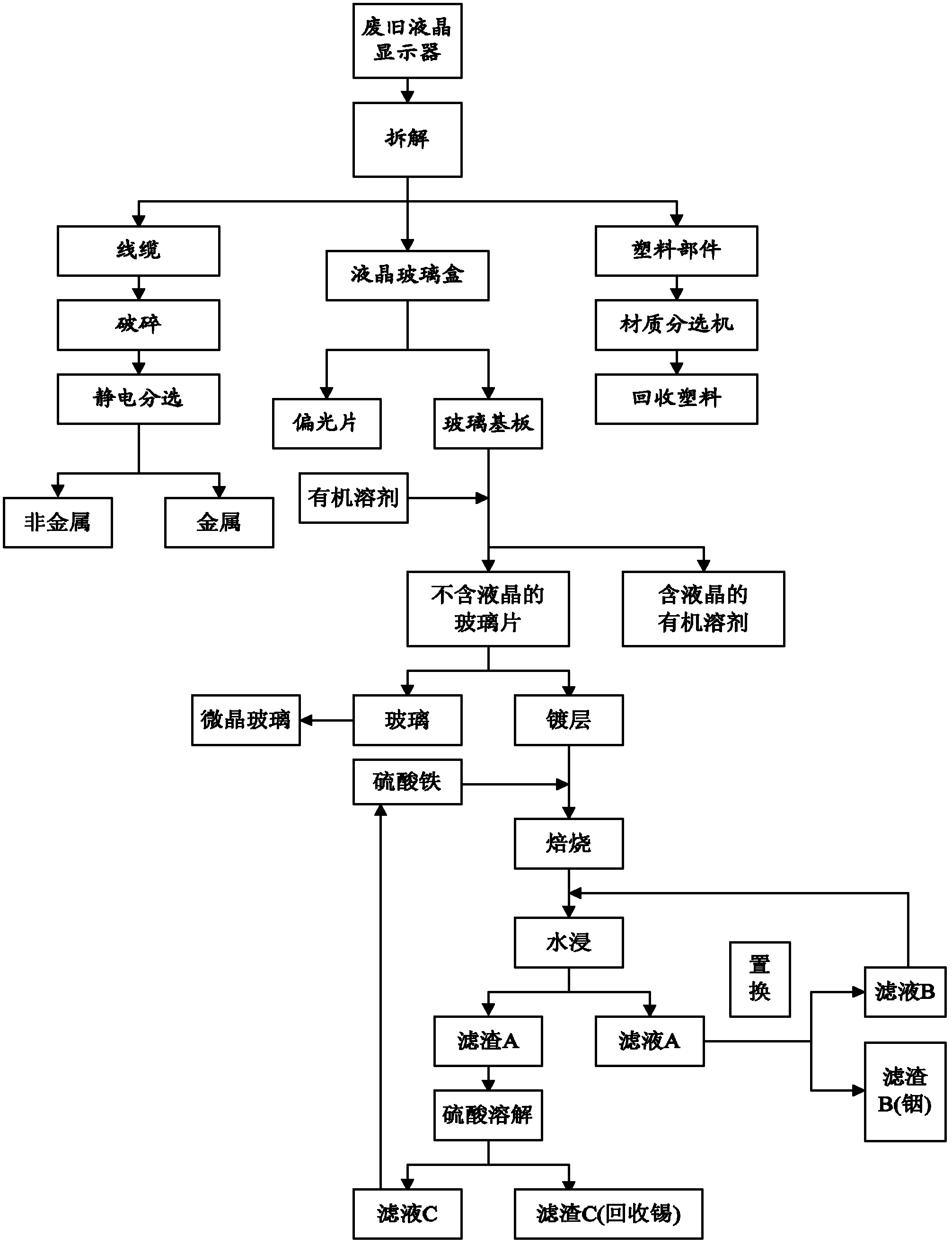Comprehensive treatment method for waste liquid crystal display
A liquid crystal display and comprehensive treatment technology, applied in the field of waste resource treatment, can solve problems such as environmental pollution, mercury-containing fluorescent lamps, mercury leakage, etc., and achieve the effects of significant economic benefits, reduced interference, and reduced pollution
- Summary
- Abstract
- Description
- Claims
- Application Information
AI Technical Summary
Problems solved by technology
Method used
Image
Examples
Embodiment 1
[0032] A comprehensive treatment method for waste liquid crystal displays, comprising the following steps:
[0033] (1) Disassemble the discarded liquid crystal display, and remove the plastic parts, cables and liquid crystal glass box;
[0034] (2) Remove the polarizer from the liquid crystal glass box, mechanically peel off the glass substrate, and sell the waste polarizer to recycling manufacturers;
[0035] (3) dissolving the liquid crystal with ethanol under ultrasonic waves on the stripped glass substrate, the mass ratio of the added ethanol to the liquid crystal is 50-100:1, then fractionating the ethanol and the liquid crystal, collecting the liquid crystal, and recycling the ethanol;
[0036] (4) get the glass sheet not containing liquid crystal in step (3), scrape off the coating that contains indium oxide and tin dioxide, then make glass ceramics after the glass sheet is cleaned;
[0037] (5) Take 20g of the scraped coating, mix with 40g of ferric sulfate, roast at...
Embodiment 2
[0041] A comprehensive treatment method for waste liquid crystal displays, comprising the following steps:
[0042] (1) Disassemble the discarded liquid crystal display, and remove the plastic parts, cables and liquid crystal glass box;
[0043] (2) Remove the polarizer from the liquid crystal glass box, mechanically peel off the glass substrate, and sell the waste polarizer to recycling manufacturers;
[0044](3) dissolving the liquid crystal with diethyl ether under ultrasonic waves on the stripped glass substrate, the mass ratio of the added diethyl ether to the liquid crystal is 50 to 100: 1, then fractionating the diethyl ether and the liquid crystal, and collecting the liquid crystal, and recycling the diethyl ether;
[0045] (4) get the glass sheet not containing liquid crystal in step (3), scrape off the coating that contains indium oxide and tin dioxide, then make glass ceramics after the glass sheet is cleaned;
[0046] (5) Take 20g of the scraped coating, mix with ...
Embodiment 3
[0050] A comprehensive treatment method for waste liquid crystal displays, comprising the following steps:
[0051] (1) Disassemble the discarded liquid crystal display, and remove the plastic parts, cables and liquid crystal glass box;
[0052] (2) Remove the polarizer from the liquid crystal glass box, mechanically peel off the glass substrate, and sell the waste polarizer to recycling manufacturers;
[0053] (3) dissolving the liquid crystal with acetone under ultrasonic waves on the stripped glass substrate, the mass ratio of the added acetone to the liquid crystal is 50-100: 1, then fractionating the acetone and the liquid crystal, and collecting the liquid crystal, and recycling the acetone;
[0054] (4) get the glass sheet not containing liquid crystal in step (3), scrape off the coating that contains indium oxide and tin dioxide, then make glass ceramics after the glass sheet is cleaned;
[0055] (5) Get 20g of the scraped coating, mix 40g of ferric sulfate, roast at ...
PUM
 Login to View More
Login to View More Abstract
Description
Claims
Application Information
 Login to View More
Login to View More - R&D
- Intellectual Property
- Life Sciences
- Materials
- Tech Scout
- Unparalleled Data Quality
- Higher Quality Content
- 60% Fewer Hallucinations
Browse by: Latest US Patents, China's latest patents, Technical Efficacy Thesaurus, Application Domain, Technology Topic, Popular Technical Reports.
© 2025 PatSnap. All rights reserved.Legal|Privacy policy|Modern Slavery Act Transparency Statement|Sitemap|About US| Contact US: help@patsnap.com

